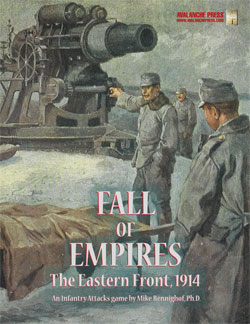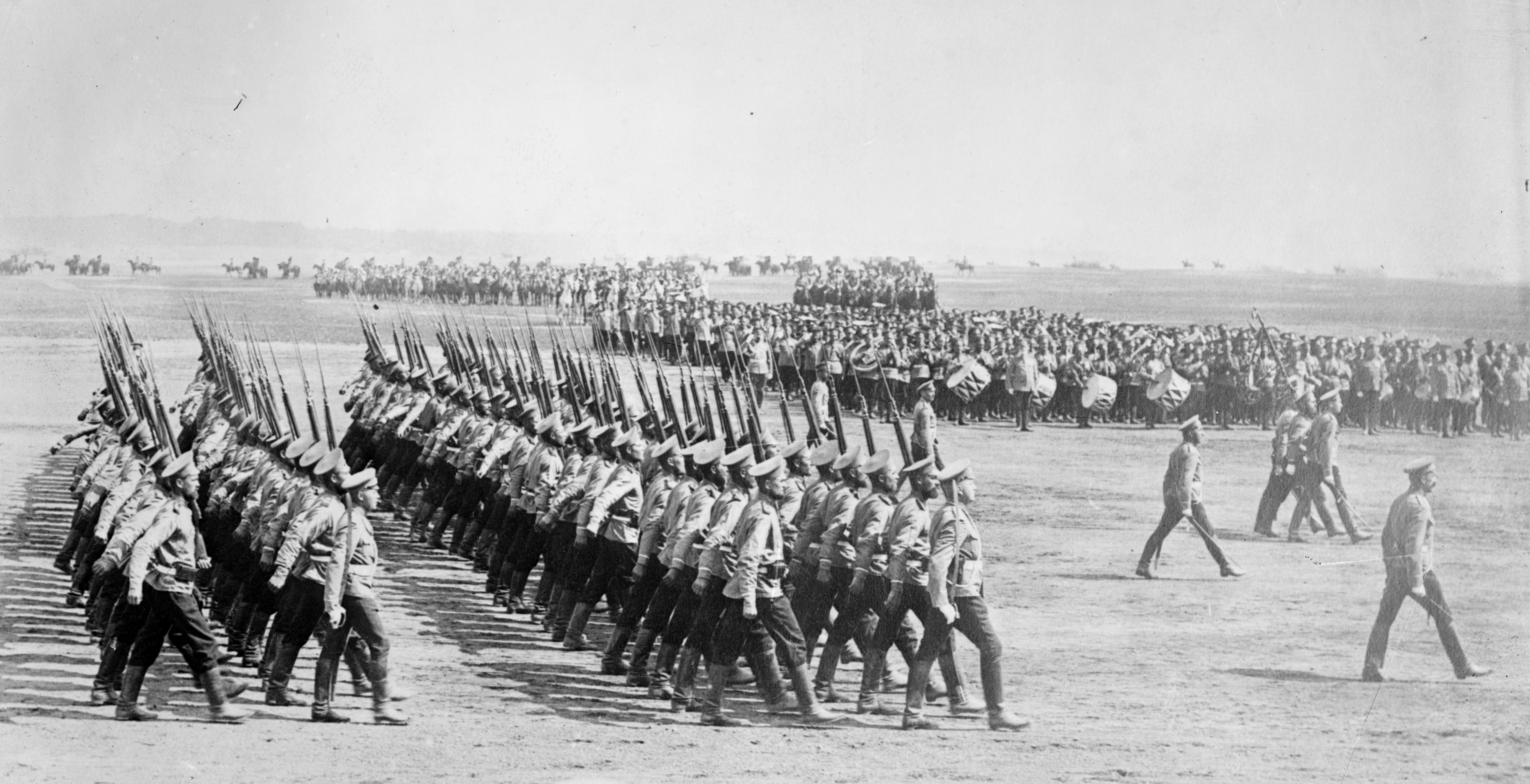| Fall of Empires:
The War Begins
By Mike Bennighof, Ph.D.
June 2023
 That Austria-Hungary’s declaration of war against Serbia would trigger a response from Imperial Russia surprised no one in Vienna. Even so, the Imperial and Royal Army entered its last war spectacularly unprepared for active operations. That Austria-Hungary’s declaration of war against Serbia would trigger a response from Imperial Russia surprised no one in Vienna. Even so, the Imperial and Royal Army entered its last war spectacularly unprepared for active operations.
Serbian terrorists murdered Archduke Franz Ferdinand on 28 June 1914; despite the increasing likelihood of war the Austro-Hungarian military and political elite did not cancel their July vacations and headed for the mountains and lakeshores as planned. When they returned in late July, Austria-Hungary declared war on Serbia (on 28 July). Orders for full mobilization only came three days later: a day after Serbia’s protector, Russia, ordered full mobilization. A declaration of war against Russia came on 6 August, a week after Austria-Hungary’s ally Germany had done so.
Austria-Hungary mobilized 48 infantry and 11 cavalry divisions in August 1914, plus 24 independent infantry or mountain brigades. Of those 48 divisions, 32 of them came from the Common Army, and eight each from the regular armies of the Dual Monarchy’s two halves: The Imperial-Royal Austrian Landwehr and the Royal Hungarian Honvédség. Two of the cavalry divisions came from the Honvédség and the remainder from the Common Army; the Landwehr’s cavalry component was comparatively small (it maintained its own mountain troops instead).

Kaiser Franz Josef greets the 1st Kaiserjäger Regiment.
Landwehr and Honvédség units were regular outfits, not reserves or militia as they are sometimes labelled by the ignorant. They drew from the same draft pool as the Common Army: low lottery numbers went to the more prestigious Imperial and Royal forces, higher ones to the national armies. Their peacetime cadres were smaller than those of Common Army battalions, which hampered their training, and the Common Army had first pick of officer candidates as well. The Landwehr and Honvédség had only been declared part of the first line in 1908, however, and were definitely less efficient than the Common Army.
Those 59 divisions would be organized into six field armies at the outbreak of war. Two of the armies would face off against Serbia, three against Russia, and one would be held back to deploy on either front as the political situation dictated. In theory, that gave Austria-Hungary flexibility lacking in the war plans of other nations; in practice, it only contributed to the unfolding disaster.
For decades, Austria-Hungary’s military budgets and recruiting quotas had been markedly lower than those of other Great Powers, even as the economy and population grew. Both had been frozen in 1889, and while the Austrian parliament signaled a willingness to increase spending and recruiting, its counterpart in Budapest stoutly refused without more concessions to Magyar nationalism. Only in 1912 did the Hungarian parliament agree to increase the flow of cash and conscripts, far too late to have much of an impact on the size and readiness of the armed forces.
Both military and political leaders had desperately urged that step since the turn of the century. Rudolf Kiszling, one of the great figures of Austrian military history, estimated that had the budget and recruit intake been raised then to the levels finally granted in 1912, Austria-Hungary would have disposed of another 22 infantry divisions in August 1914 (14 in the Common Army, and four each from the Landwehr and Honvédség). Additionally, the Common Army had a large pool of unorganized reservists and planned to introduce a German-style system that would have raised another 14 reserve infantry divisions and a similar number of reserve mountain brigades, plus 16 more reserve brigades in the Landwehr and Honvédség.
Yet simply adding more than half again as many divisions and brigades to the Habsburg order of battle would not have solved the Dual Monarchy’s military problems. Some of the difficulties were financial in origin, others social, but all of them crippling.

Austro-Hungarian medium-caliber artillery: a 100mm piece.
Artillery was not simply in short supply, it was hopelessly outdated. The most modern pieces, the M05/08 8cm light field guns, were still technologically well behind the similar field guns of other nations and the older obsolete M99 remained in service. Both had steel-bronze barrels, a composite developed for its lower cost which turned out to perform poorly in action (while some sources claim that Austro-Hungarian producers could not make a true steel artillery barrel this is not true; Skoda produced very fine naval guns and later very good artillery). A new design with a true steel barrel had been submitted and evaluated, but lay beyond the Army’s budget. The 10cm M99 medium field howitzer was even more hopelessly out of date; a new M14 10cm howitzer had just begun to enter service.
Each Austro-Hungarian infantry division had 54 artillery pieces on paper, but a shortage of guns stemming from the creation of Landwehr and Honvédség divisions had still not been made good and the infantry divisions actually averaged about 42 tubes each. A German division, in contrast, had 72 of its own and could call on more from its corps headquarters, which in turn had many more guns than its Austro-Hungarian counterpart.
Those numbers don’t tell the full story. On paper, Common Army infantry division was a gigantic organization, with four infantry regiments each of four battalions. And those battalions were slightly larger than those of most other armies. Landwehr and Honvédség divisions had just three battalions in their regiments, for a more reasonable (but still large) total of 12. Thus an Austro-Hungarian division had 42 guns for its 16 battalions (less than three guns per battalion) where the 72 guns of a German division supported 12 battalions (six guns per battalion).
And yet these were not the greatest handicaps faced by the Habsburg forces. As commander-in-chief, Franz Conrad von Hötzendorff had been responsible not only for the Army’s inept tactical doctrine, but for its preposterous strategic outlook as well. Conrad planned to go on the offensive immediately, in a sweeping offensive toward Warsaw to meet the Germans striking south from East Prussia, even though the German chief of staff, Helmuth von Moltke, had expressly told Conrad that Germany would make no such moves. Austrian staff officers – the elite “bottle-green boys” in their special dark green trousers – had assumed that Austria-Hungary could mobilize its armies much faster than could the Russians. Yet this was not the case: the railway section maintained peacetime speed limits and meal schedules, and the troop trains shuffled into Galicia, the Austrian province facing Russian Poland, very slowly.
Austro-Hungarian war plans had been betrayed to the Russians before the war, and to compensate for this, Conrad simply shifted all the assembly areas 100 miles to the west. Thinking better of this, he then ordered the troops to march back part-way to the east. Between the slow-speed trains and the extra counter-marching, by the time the exhausted Austro-Hungarian armies made it to their jumping-off spots, the Russians were also in place.
This did not bother Conrad. The offensive would go forward as planned.

The Steamroller prepares for war.
On the other side of the border, the “Russian Steamroller” mobilized 115 infantry divisions and 38 cavalry divisions. The Russians detached substantial forces to cover the capital at St. Petersburg against German seaborne landings, and at Odessa to prevent the Turks from doing the same. Large forces also were detailed for the invasion of East Prussia, which the Russians had promised their French allies would be executed at the earliest possible moment.
That still left a substantial force in southern Poland facing the Austrians in Galicia: 46 infantry divisions and 18 cavalry divisions, organized into four armies. Like those of Austria-Hungary, a Russian infantry division had four regiments each of four battalions, for a total of 16. A Russian infantry division wielded 60 field guns, most of them the 76.2mm M1902 produced by the Putilov Works. This was a far better weapon than the Austrian pieces, with greater range and striking power. The Russians had the experience of the recent Russo-Japanese War to guide their use of artillery on the battlefield, though they managed to ignore most of it.
Russian battlefield intelligence was much worse than that of Austria-Hungary, and even with Conrad’s last-minute decision to march eastward the redeployment fooled the Russian Southwestern Front’s commander, Nikolai Ivanov. Expecting to find the enemy much further to the east, Ivanov deployed his four armies in two pairs and planned to crush the Austrians between them. Instead of being caught within the Russian pincers, the leftmost Austrian force, Viktor Dankl’s First Army, was positioned to catch the rightmost Russian formation, Anton von Salza’s Fourth Army, in its right flank. Thanks to stupidity even greater than his own, Conrad had the opportunity to strike two Russian armies with two much larger armies of his own even though the Russians held a substantial numerical advantage in the theater.
On 22 August 1914 Conrad ordered his troops forward. Knowing nothing of this, Ivanov ordered an advance on the same day. And so both Austria-Hungary and Imperial Russia began their last war.
You can order Fall of Empires right here.
Infantry Attacks Package
August 1914
Fall of Empires
Franz Josef’s Armies
Winter’s Battle
Retail Price: $212.96
Package Price: $170
Gold Club Price: $136
You can experience the Infantry Attacks Package right here.
Sign up for our newsletter right here. Your info will never be sold or transferred; we'll just use it to update you on new games and new offers.
Mike Bennighof is president of Avalanche Press and holds a doctorate in history from Emory University. A Fulbright Scholar and NASA Journalist in Space finalist, he has published a great many books, games and articles on historical subjects; people are saying that some of them are actually good.
He lives in Birmingham, Alabama with his wife and three children. He misses his Iron Dog, Leopold.
Want to keep Daily Content free of third-party ads? You can send us some love (and cash) through this link right here.
|
